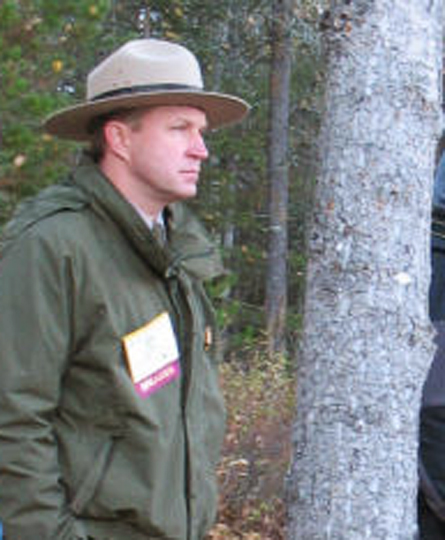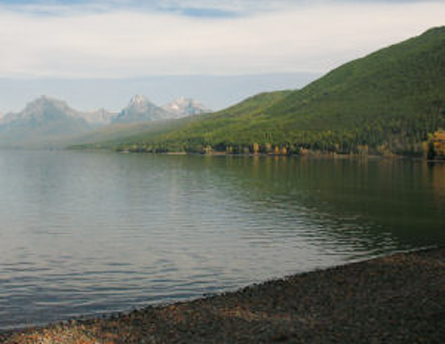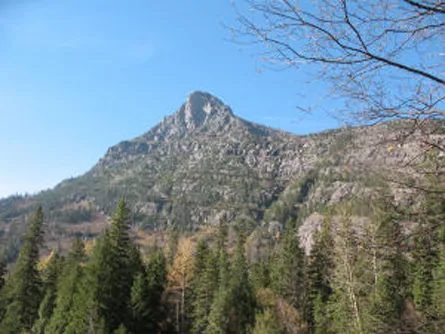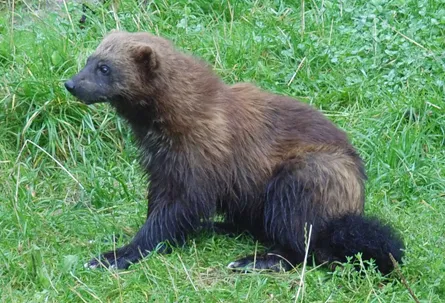Wolverine: Climate warming threatens comeback
New data point to unexpected sociability and filial behavior
Glacier National Park, Montana—Long viewed as mean, belligerent and solitary, wolverines appear to have gotten a bum rap, according to new research conducted at Glacier National Park.




This character assassination is not all that surprising. Observes National Park Service biologist John Waller: “Wolverines are probably one of the least studied, least understood denizens of the northern Rockies.”
Waller described some of his team’s accumulating data on this misunderstood carnivore with reporters, October 14, as part of a field trip associated with the Society of Environmental Journalists’ annual meeting in Missoula, Mont. They visited Glacier, the nation’s tenth national park, in this, its centennial year.
One new wolverine insight: the role visiting dads play in their offspring’s lives.
Males typically mate for life with several females, each of whom maintains her own exclusive home range. The guys had been suspected of being absentee dads, donating little more than their genes. In fact, tracking data indicate that males make the rounds, visiting mates’ dens — presumably to help protect infants. Dads periodically return again throughout the year to spend time with their juveniles — essentially showing them by example what it means to be wolverine, observes Waller.
This emerging vision of sociability is shattering the myth that these big bruisers of the weasel family are its equivalent to feisty misanthropes.
The good news: After being virtually extirpated from its U.S. range by 1930, the animal has been staging a comeback in recent decades, notes former U.S. Forest Service biologist Jeffrey Copeland, who has studied the animals for decades — including at Glacier National Park. Over the past several decades, wolverines have been recolonizing Glacier’s 400,000-plus hectare (million acre) wilderness and other regions in the Rocky Mountain West.
But concern is developing about the species’ ability to maintain its hold on this reclaimed habitat. The deeply snow-covered environment in which these animals have evolved to raise their young is diminishing due to climatic warming, federal scientists at the park report. And that, Waller and Copeland say, threatens the survival of coming generations of wolverines.
Walking fools
“Glacier Park probably supports the densest population of wolverines in North America — indeed, one of the densest in the world,” Copeland says. But that’s not saying much. The park hosts perhaps 300 grizzlies. In contrast, its preliminary wolverine census has tallied only 40 to 50 animals, including some 18 breeding females. “Across the entire contiguous United States there may be only 300 [wolverines],” he says.
Then again, this animal has always lived at extremely low population densities. These predators sprawl by choice, Copeland says. A female may homestead up to 200 square kilometers (77 square miles) and males can stake claims to territory more than twice that size. So the wolverine abundance in Glacier National Park is probably what it was centuries ago, he says.
But that’s raised a niggling question: How could such widely dispersed animals reliably find each other so that they could sustain stable, breeding populations? After all, Copeland notes, they routinely exist at densities below which the conservation community has estimated any species can survive long term.
Radio-tracking data at Glacier, which began around 2003, now suggest an answer: The animals are trekking fools.
They walk and walk and walk. And then they climb and walk some more. It’s almost as if they feel some imperative to be on the move. Within the park, wolverines can traverse 150 to 200 kilometers per week.
Some of the tracking data came from GPS collars, which logged an animal’s position every 5 minutes for weeks to months. They uncovered a big surprise: the wolverine’s dogged determination to reach its destination. While some animals amble along, stopping to explore distractions here and there, wolverines don’t. Some animals plot paths that keep them hidden in timber; wolverines don’t. If its internal compass tells a wolverine that the best route includes moving across a clearing or road, so be it.
And “although 70 percent of wolverine habitat across the planet is as flat as your desktop,” Copeland says, the animals won’t avoid inclines. One example: a wolverine was en route to a mountain-goat carcass on the far side of Mt. Cleveland, Glacier National Park’s highest peak. It was January, which means frigid and snowy. When the animal came to the base of the mountain he stopped and took a couple steps back. “It was if he was asking: ‘Do I really want to do this?’” Copeland says. But after a short pause, the animal forged ahead.
“He ascended over 5,000 feet vertical and crossed the very top of Mt. Cleveland. And he did it in 90 minutes,” Copeland says. Tracking data from more than 20 animals, collected over the course of five years, showed that such tenacity and endurance is far from unusual. For the wolverine, what would seem extreme is merely routine.
Males, in particular, patrol their range to keep interlopers out. They pair-bond with two or three females for life (they live 8 to 10 years) typically producing two to five litters with each mate. However, the sex ratio among members of this species is one-to-one — which means roughly two guys in three may not get mates and pass along their genes.
Outsider males aren’t content with this, which means they’re always trying to unseat a family guy and take over his small harem. Which may in part explain why males incessantly scout throughout their range.
Dutiful dads
As each wolverine was fitted with a GPS collar, the animal’s identity and vital details were logged. Tracking data would later show that males frequently checked on their mates’ dens prior to the kits’ weaning (at about 10 weeks of age). That was a surprise, Waller says, as was evidence of later visits to spend time with older offspring.
Males tend to ignore the dens after their young are weaned. But by six-months old, some young are on their own, “wandering around and trying to figure out how to be a wolverine,” Copeland says. “And it’s then that they seem to make contact with dad again.” Whether elder or youngster takes the initiative is uncertain. But with the GPS data, “we see two animals that we know are related come together and travel together for days.” From an airplane, Copeland witnessed a trio of these ostensibly solitary relatives together: an adult male, a yearling male and a two-year-old female “out-year sibling.”
Such behavioral data indicate that wolverines are sociable — as neighborly, Waller says, as they can be when the nearest homestead may be 50 kilometers away and across a mountain top or two.
As for fearing people, Copeland says that’s just “ridiculous.” Like other members of the weasel family, wolverines are inherently curious “and fearless.”
Hairy data
Now that the tracking study is over, Waller’s team is continuing to indirectly track the movements and identity of park wolverines from DNA in the fur they’re encouraged to leave behind.
Encouraged? “One of the challenges of studying wolverines is that they live in some of the most inhospitable terrain in the Lower 48,” Waller notes. And they’re always on the move. So to find out who’s been through a particular region, park scientists bait the tops of broken trees for these scavengers with meat. Then they affix bottle brushes around the trunk of the tree.
As hungry wolverines ascend to the food, some of their fur gets caught in the brushes’ bristles. Every few weeks, the researchers trek out to rebait the sites and retrieve fur to identify who’s been in the neighborhood.
“We do this in winter, while bears are sleeping,” Waller explains, “because we don’t want to encounter a grizzly while we do this work.” And they wait for the better weather, since in this part of the country, temps often hover well below zero and prolonged winds can howl — sometimes over 100 miles per hour.
Climate concerns
“We’ve always known there was a strong association between wolverine and snow,” Copeland says. “It’s an animal that evolved in a snowy arctic environment.”
That snow proves especially important for moms. Around February they look for the ideal site to burrow in and create a den. This temporary home has to survive until their pups wean, around mid-May, which means deep snow has to persist that long. And real estate that meets those criteria is becoming increasingly limited.
“Glacier [National Park] has become a poster child for shrinking glaciers,” notes Amy Vanderbilt, a park spokeswoman. Currently, the park hosts about 25 named glaciers — just a sixth of those present in the early 20th century.
Erich Peitzsch of the U.S. Geological Survey, who’s been studying snow and ice at the park, notes that its glaciers have been melting rapidly. Computer modeling, based on site sampling of ice losses, indicates that the park’s iconic glaciers may all vanish “by 2020 to 2030.”
Spring thaws of seasonal snow has also been occurring increasingly earlier, he notes. And that could spell a big problem for young-of-the-year wolverines.
Copeland and his colleagues analyzed all known den sites for wolverines around the world — some 600 in all. Then they compared these to sites where spring snow melt occurred after mid-May. “One hundred percent of those dens fell in this region, what we refer to as a bio-climatic envelope,” he notes. His group then compared this zone to where wolverine have been spotted. And they found that this late-spring-snow zone “also defines the area where wolverine live year-round 90 percent of the time.”
Most disturbing, he says, “If these animals were able to adapt to denning outside of this spring-snow zone, I think we’d be seeing it.”
Soon to star on TV
On November 14, 2010, PBS will debut an hour-long documentary, “Wolverine: Chasing the Phantom.” Its writer and producer, Gianna Savoie, describes the animal as not only her favorite subject, but also “the ultimate paradox.” She told me they “are simply the essence of mystery, the essence of wildness — tough yet vulnerable.” In sum, an animal “that is fiercely intelligent, social and curious.”
Encountering some in captivity, she found it “a little unsettling” to be so close to animals reputed to be not only aggressive but also ferocious. In fact, they proved anything but — at least on that occasion. She said they were “downright playful, climbing on my back and sniffing my ear, rolling around and wrestling with each other, running up to my camera man — not to attack but to inspect the camera.”
There remains little research on the wolverine, which is why the nonprofit Wolverine Foundation is working hard to drum up private support for studies of the animal. “We need far more,” Copeland argues, because “for too long we have simply relied on myth and legend to define our understanding of this amazing animal.”






